monster movies
|
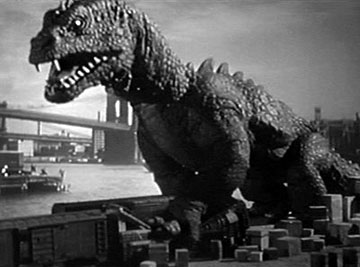
The
Beast From 20,000 Fathoms crawls out the river to make
a visit upon New York City.
|
(10/08) One of my favorite films is entitled The
Beast from 20,000 Fathoms. I first saw this on TV as a kid
way after its 1953 release date and have been in love with monster
movies (also known as "creatures features") ever since. Who
couldn't love this film? A dinosaur, trapped in Arctic ice for
a 100 million years, is awakened by an atomic bomb test and swims
south to find his old stomping grounds - the Hudson River next
to New York City - infested with pesky human beings. While trying
to re-acclimate to his new surroundings, the beast makes a visit
to Coney Island, where, amid a burning roller coaster, he falls
victim to a scientist with a radioactive rocket.
The Beast from 20,000 Fathoms is a great
film. It doesn't really matter that the dinosaur didn't really
come from 20,000 fathoms. It doesn't matter that nothing could
survive locked in ice for 100 million years. It doesn't even matter
that the type of dinosaur in the story - a Rhedosaurus
- never even existed. What does matter is the film captures the
viewer's imagination and sense of adventure.
The Beast from 20,000 Fathoms was the first
of a wave of science oriented monster movies that appeared in
the late 40's and early 50's. The history of the monster movie
goes back much further, however. All the way to the era of silent
films.
The first commercial film appeared in 1898 and less
than 20 years later movie makers had turned to monsters as their
subjects. The first creature feature appeared in Germany in 1916
and was entitled The Golem. The Golem was based
on an old Jewish legend about a rabbi who makes a figure out of
clay and endows it with life to act as his slave. Though the film
has been remade several times, we know very little about the original
production as only fragments of the movie have survived.
[Just after writing this
article I found out that an even earlier monster movie exists:
a 15 minute version of Frankenstein done by Edison Studios in
1910. This was lost for many years but recently found and released
on DVD.]
|
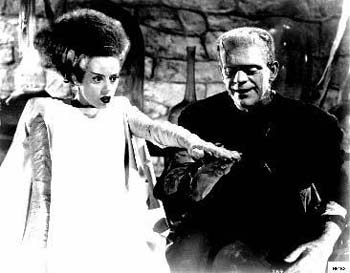
The
Frankenstein Monster meets his future mate in The Bride
of Frankenstein.
|
What
Makes a "Creature Feature?"
Perhaps it is time we defined our terms. Just what
makes a monster movie a monster movie? Well, creature features
are not really an official academic genre like horror, science
fiction or fantasy. It actually cuts across those categories.
It is generally agreed that any film that involves a fictional
creature (or creatures) who are in conflict with humans can be
classified as a monster movie.
Now note the words fictional creature. That means
that a movie concerning say something like your regular, everyday,
average lion, wouldn't qualify. Lions are real, not fictional,
so they don't count. However, if you were to make the lion several
times its normal size (a monstrous size, so to speak) like the
sabertooth in 10,000 B.C., you have a fictional creature
and a monster movie.
In addition to including a fictional creature, many
monster films, though not all, include these additional "classic"
characteristics:
1)
The movie almost always serves as a cautionary tale. Humans do
something they shouldn't, or perhaps fail to do something they
should, and unleash the creature into our unsuspecting world.
2)
Often there is a character who warns either about how doing whatever
they are doing will unleash the creature or warns that the creature
has been unleashed. This person is met with disbelief or even
ridicule.
|
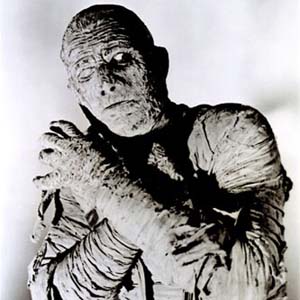
Boris
Karlof was not only the original Frankenstein, but starred
in the 1932 production of The Mummy.
|
3)
The creature often threatens the "love interest" of the hero.
4)
The creature is in circumstances beyond its control and the viewers
feel sympathy for it.
5)
Some kind of new technology is used to defeat the creature.
Now, not all monster movies have all these "classic"
themes, but most have at least some of them. Let's look at one
of the earliest monster films, Frankenstein, and see how
it stacks up.
The
Universal Monsters
Frankenstein, released in 1931, was one of
a series of classic horror films Universal Studios made starting
in the 1920's and running through the 1950's. Some of the others
include Dracula (1931), The Hunchback of Notre Dame
(1923), The Mummy (1932), Bride of Frankenstein
(1933), The Wolfe Man (1941), Phantom of the Opera
(1943) and Creature from the Black Lagoon (1954). These
were enormous money makers for Universal and most spawned one
or more sequels. Even today, Universal continues to merchandise
these critters for a tidy profit.
Probably the best known of these films is Frankenstein.
Since it debuted over seventy years ago I really doubt that many
people today have seen the actual film or any of its four sequels.
However, pretty much everybody recognizes the unique makeup that
Jack Pierce designed for actor Boris Karloff. With its flat-topped
head, facial stitches and neck bolts, the creature's continence
has become synonymous with horror movies. Look around your local
store as Halloween approaches and try to count the number of products
bearing the image of the Jack Peirce design.
|
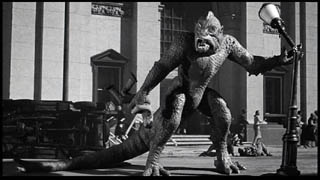
A
Harryhausen creature tears up the city of Rome in 20
Million Miles to Earth.
|
Frankenstein, of course, is based on the
19th century book by Mary Shelly. The story of a mad scientist
who conquers the mystery of life by patching together a man from
graveyard castoffs had been around for over a century before Universal
made it into a movie, yet once the film appeared, Jack Pierce's
vision of the monster became forever linked with the tale.
Does Universal's production of the film fit the
monster movie mold? On most points it does. It is certainly a
cautionary tale telling us that man should not play God by creating
life (1). When Dr. Frankenstein ignores the warnings of his old
professor (2) and gives life to the creature anyway, it runs out
of control, frightening the villagers and killing a little girl
(though accidently and not with malice). The creature even threatens
Frankenstein's fiancée, Elizabeth (3). Still, the audince feels
bad for the monster as it seems only to be looking for a little
love (4). The only part of the formula that doesn't really match
is the idea that some kind of new technology is used to destroy
the creature: Frankenstein is the victim of fire, probably the
oldest technology of them all.
Giant
Monsters
There is a second type of creature movie, somewhat
distinct from the first, involving giant monsters. Though
you might argue that The Lost World (a 1925 film based
on the Arthur Conan-Doyle book about an expedition that finds
dinosaurs alive in the remote reaches of South America) is really
the first film to feature such oversized creatures, 1933's King
Kong is easily its most famous early member of this sub-genre.
|
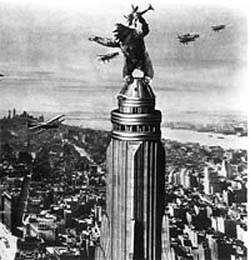
King
Kong verses the airplanes at the top of the Empire State
Building in the 1933 creature feature.
|
Kong was the brainchild of film maker Merian
Cooper. Cooper was originally producing real-life adventure movies
and had spent some time filming African gorillas. When he heard
the story of Douglas Burden's 1928 expedition to a remote South
Pacific Island to bring a giant Komodo dragon back to New York
City, he realized he had the basis of a great story. He switched
the giant lizard for a giant ape, threw in some dinosaurs, added
a love interest in the person of a beautiful blond and soon had
the script for King Kong.
Kong, of course, is the quintessential giant
monster movie and fits the formula almost perfectly: a movie producer,
instead of just filming the oversized ape, tampers with nature
by bringing the creature back to civilization only to have it
get loose. Despite warnings from the ship's first mate about letting
the movie producer's star, Anne Darrow (played by the famous Fay
Wray) go on the expedition, she is allowed to get too close to
the beast and captures its heart. The beast then captures her
body and she must be rescued from him not just once on the island,
but also when he takes her to a romantic rendezvous at the top
of the Empire State Building. Despite this, its hard not to feel
sympathy for Kong lost in the strange world. Of course the characters
in the picture don't see it that way and new technology in the
form of the airplane sends the creature plunging to his death.
The film is probably the first special effect blockbuster
ever made. Though many of the techniques used to make the film
pre-existed Kong, this is the first film where they were
brought together to such good effect. Kong and the dinosaurs were
stop-motion puppets (perhaps 18 inches
high) filmed on a miniature set. Though special effects wizard
Willis O'Brien had used stop-motion on Lost World, he perfected
the art on Kong. A new, larger and more effective back
projection system was also used to combine O'Brien's monsters
with the real actors in ways not seen before. Willis also used
a similar method, miniature projection, to place previously filmed
actors onto the miniature sets with his monsters.
Though the film's effects are impressive, the movie
would not have been a success without a solid story. The "Beauty
and the Beast" theme makes Kong a creature we care about,
not just another marauding monster to be rid of. The film inspired
a number of people to go into movie making including director
Peter Jackson, who remade a sumptuous version of the film in 2005.
Ray
Harryhausen Films
|
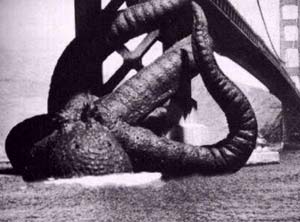
Ray
Harryhausen used stop motion photography to give life to
the giant octopus in It Came from Beneath the Sea.
|
Another person inspired by Kong was a young
man named Ray Harryhausen. Harryhausen
was so fascinated by the stop motion effects in the film that
he built a studio in his parents' garage to experiment with the
technique. He took a demo reel to show to Willis O'Brien and got
himself a job working with him on several Kong sequels.
By 1953 Harryhausen was ready to strike out on his
own by doing the effects for the aforementioned Beast from
20,000 Fathoms. The producers of the film got the idea from
a short story called "The Foghorn" written by Ray Bradbury. Bradbury's
story centered around a revitalized dinosaur that's attracted
to a lighthouse's foghorn, thinking it's a possible mate and when
he finds out it isn't knocks the structure down in frustration.
The producers of the movie liked the idea and decided to build
a movie around it, but didn't tell Bradbury they were using it
in order to save paying him the proper fees. By the time they
had the first draft of the script written they'd forgotten from
where they had stolen the idea and hired Bradbury to do a re-write.
Bradbury, of course, recognised the idea as his own and forced
the producers to give him the credit (and the money) as the source
of the story.
The Beast from 20,000 Fathoms fits almost
perfectly into the monster movie structure: tampering with nature,
warnings ignored, sympathetic monster and science prevails. The
picture was a huge success leading to a rash of giant monster
movies and a career in visual effects for Harryhausen. After that
he worked on 15 monster movies over the next thirty years and
his name on a film became, to connoisseurs of the monster genre,
as important as those of the lead actor or director. His works
include some of the finest monster movie ever made including:
It Came from Beneath the Sea, Earth Verses the Flying Saucers,
20 Million Miles to Earth, The Seventh Voyage of Sinbad, Mysterious
Island, Jason and the Argonauts, One Million Years B.C., The Golden
Voyage of Sinbad and Clash of the Titans.
|

One
of the most famous of the 50's monsters, Godzilla, originated
in Japan and spawned 27 sequels.
|
Space
Monsters of the 50's
Giant Monsters weren't the only successful creature
films of the era, however. While the public was concerned with
atomic bomb (giving movie producer ample excuses to grow ordinary
animals to preposterous proportions, as in Deadly Mantus,
The Giant Gila Monster and Tarantula), the space
race made aliens a hot topic. A number of monster/alien films
appeared in the late 40's and 50's. The best included The War
of the Worlds (based on the H.G. Well novel), The Day the
Earth Stood Still, and Forbidden Planet. Numbered with
the worst were Robot Monster (where the robot alien invader
was a man wearing a gorilla suit with a space helmet) and Plan
9 from Outer Space produced by the infamous Ed Wood.
The 50's seem to be the start of a phase where
many of the monsters seem less sympathetic and more mindlessly
malevolent. Perhaps this was a reaction to the McCarthy Era/Communist
scare. The American public seemed less tolerant of what was different
and more fearful of anything strange.
The 50's also produced Japans classic entry into
monster films: Godzilla. A three-hundred-foot-tall aquatic
lizard who was made gargantuan by an atomic blast, Godzilla has
stamped his way through 28 films from Toho studios. Japanese filmmakers
decided not to use the stop motion approach, instead opting to
put an actor into a latex Godzilla suit so he could demolish some
of the most beautiful miniature sets ever constructed.
|
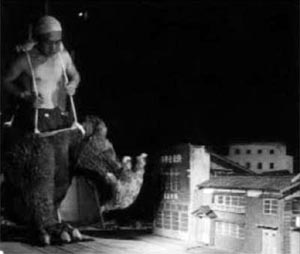
Toho
Studios used a rubber suit and huge miniature sets to produce
their Godzilla films. Here an actor uses a lower-half suit
during close ups of the feet.
|
Over the years Godzilla has changed from trashing
Japan to being its protector (some argue that the Japanese relationship
with the outsized lizard is symbolic of the Japanese relationship
with the United States). He often teams up with other giant monsters
or finds himself opposing them as in Godzilla vs. King Ghidorah
(a three-headed dragon like monster). He has even spawned a hole
sub-genre called Kaiju (literally strange beast)
which includes rival studio Kadokawa Picture's Gamera,
a 300-foot-tall biped turtle.
The
Coming of the CGI Monsters
The next major change in monster movie history doesn't
really take place until the 1990s. By that time computers were
becoming powerful enough to do image processing at the quality
level necessary for motion pictures. The result were visual effects
that are almost impossible to differentiate from reality. One
of the first major pictures to employ this was 1991's Terminator
2: Judgment Day. The first Terminator film had used stop motion
to animate the robot (once it had lost its exterior flesh and
blood shell). Terminator II was all digital, though, enabling
many startling effects never seen before, including a liquid metal
robot that morphed seamlessly from person to object to person
before the viewers eyes.
Jurassic Park (1993) was the first film
to use digital computer effects to make dinosaurs come to life.
No longer was a filmmaker hamstrung by the limitations imposed
by stop motion. The computer, given enough time and memory, would
visualize almost anything in perfect detail. Digital effects were
also more flexible than previous methods. For example, in 1933
a scene from King Kong showing Fay Wray trapped in a tree
while a battle between Kong and T-Rex rages in back of her was
accomplished by stop-motion and back screen projection. The scene
is wonderful, but the camera is by necessity locked down in a
single location. Miss Wray is in the scene with the monsters but
they are always in the background while she is limited to the
foreground.
|
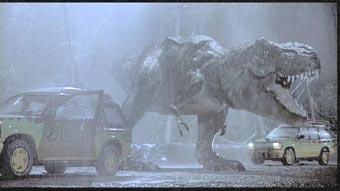
Jurassic
Park introduced digitally created dinosaurs to the silver
screen.
|
A similar scene from Jurassic Park III shows
how powerful digital effects can be. Two dinosaurs confront each
other in violent battle. The camera here is not locked in position
but moves and zooms to cover the action. Actors are no longer
stuck in the foreground, but scurry through the thick of the battle,
dodging the monsters' feet.
As O'Brien once inspired Harryhausen, Harryhausen
has inspired many of today's digital visual effects technicians.
The monster movie is alive and well in their hands. Some claim
though that CGI (Computer Generated Imagery) has made it
too easy to make monster movies, leading to films that seem to
only be driven by their special effects. 2004's Van Helsing
is an often-mentioned example of this problem. Though the
film brings back Frankenstein, the Wolf Man and Dracula, they
seem too synthetic compared to the original characters.
Modern
Monster Films
Hopefully as producers become more familiar with
CGI, we will see more creature features where this powerful tool
is used to advance the story, not replace it. There have been
some hopeful signs in the last few years: Peter Jackson's King
Kong, though a bit long, is true to the original story and
the structure of the classic monster movie. The Korean film The
Host explores a family's attempt to find their daughter after
she is kidnapped by a slimy creature living in the nearby river.
Cloverfield (2008) re-imagines the giant monster film for
the YouTube generation, as we see the whole story through
the lens of a video camera held by one of the victims during the
creature's attack on New York City.
|
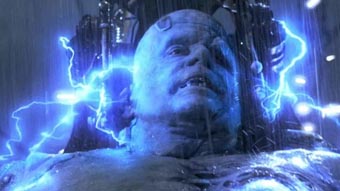
The
Frankenstein monster from Van Helsing. Too much CGI?
|
Still, this Halloween might be a good time to find
your way to the video store or library and check out the monster
movies of the past. The original Frankenstein series, King
Kong and The Beast from 20,000 Fathoms hold up pretty
well. Want a space monster? How about Forbidden Planet from
1957 or the Alien series that premiered in 1979? If you
want something on the lighter side try Mel Brook's Young Frankenstein
(1974) or the kid appropriate Abbott and Costello Meet Frankenstein
from 1948.
Any of these should give you a screaming good time.

Copyright Lee Krystek
2008. All Rights Reserved.